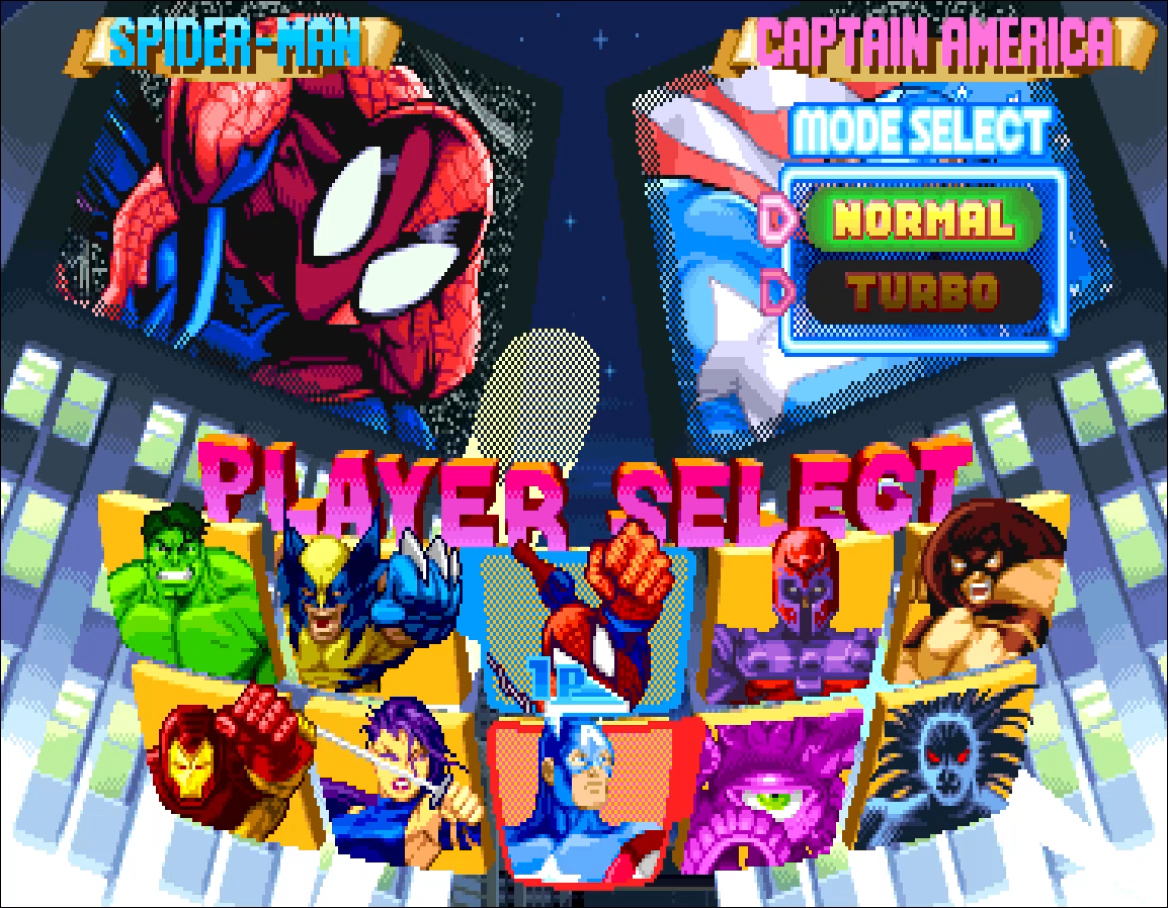
This might be my favorite character select screen with the slight arc and subtle 3D effect on the selection grid plus how the heroes/villains strategically pop out of the tiles (Spider-man’s fist, Magneto’s helmet, etc.). And I especially love the digital billboards serving as character portraits atop skyscrapers, complete with spotlights shining on them.
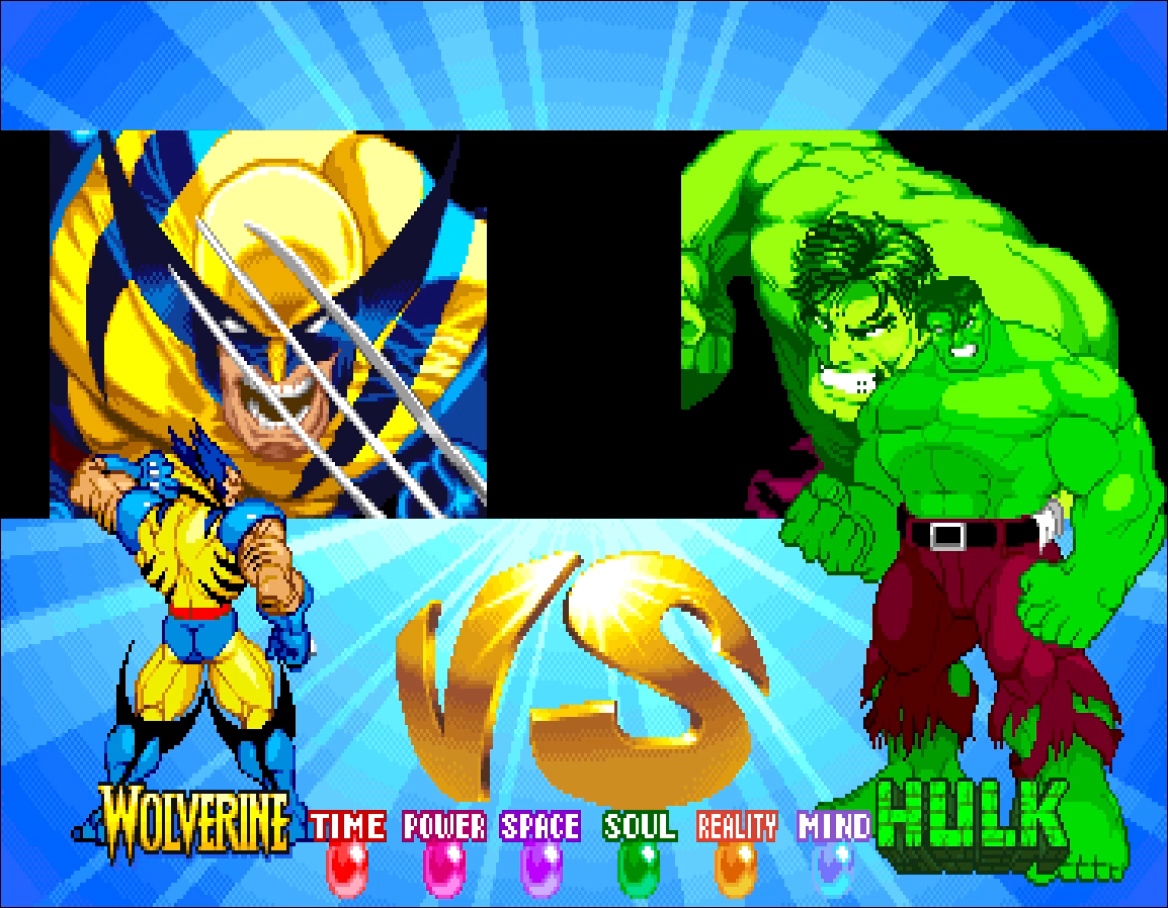
Upon selection, characters burst through the portraits and drop down to the versus screen here. Very cool. But do you know what’s even cooler? If you just want to get to the fight, press and hold any button; it speeds up the animation.
You can also speed up post-round scoring. 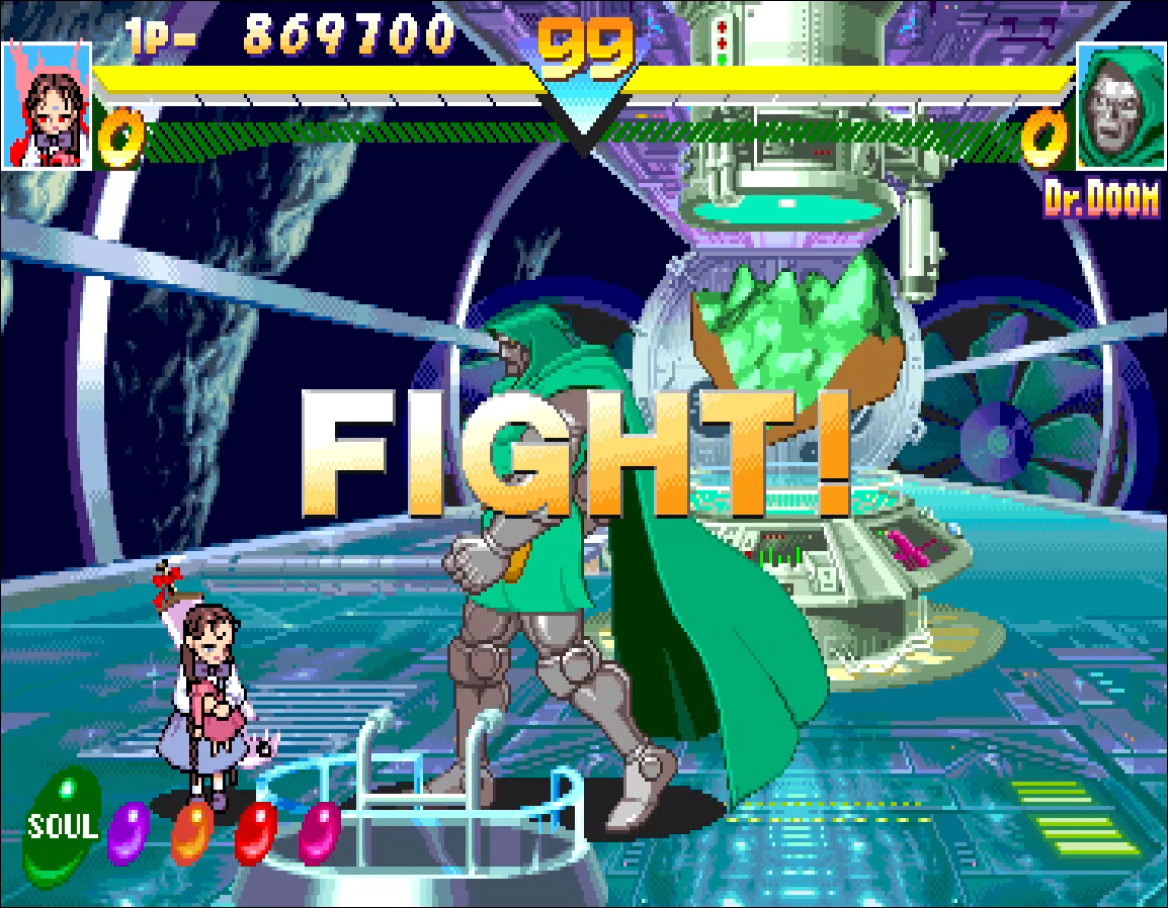
Technically, the hidden character and both bosses are playable in the Japanese arcade versions of MSH; however, it requires opening up the service door, which is trivial with emulation, less so on real hardware. Console ports make them accessible with a simple code.
Review by Jay Wilson I’m not too keen on crossovers. I prefer what you might call setting purity because a collection of fantastic characters dilutes the impact of the individuals (i.e. if everyone is special ...) That’s not to say I don’t enjoy crossovers—if you’re going to watch Godzilla destroy a city, you might as well watch Godzilla destroy a city while fighting King Kong. So, initially, I preferred this game’s predecessor, X-Men: Children of the Atom, at least conceptually. You see, I never really played COTA when it released; I didn’t see it in many arcades—probably because I stayed at home playing Samurai Shodown, Mortal Kombat II, and Street Fighter II Turbo on the Super NES, and when I did venture out, I stopped at the Tekken 2, Street Fighter Alpha, or Mortal Kombat 3 cabinets (fighting games reached their peak around ‘94/‘95.) I actually saw and played the sequel, Marvel Super Heroes, more than Children of the Atom in coin-op form. On the console front, MSH released first on the Playstation despite ads announcing COTA years before; thus, practicality forced me to rent the only pure-ish, X-Men-ish fighting game I could find. And even this comic illiterate knew these characters intermingled all the time, so how much of a crossover was Wolverine versus The Incredible Hulk? And, interestingly, Children of the Atom does a lot of things better than Marvel Super Heroes. For one, Magneto feels more like a final boss than Thanos. His stage opens up with the Master of Magnetism in the background, sitting on a throne-like control chair. He flies in to the foreground, floats down to the fight plane, and says, “You dare rise against me?” before summoning his iconic helmet and unleashing a barrage of overpowered bullshit—lighting-fast aerial projectiles, unblockable standing projectiles, complete invulnerability for a limited time, and a full-screen super move that deletes your lifebar. Thanos throws bubbles. Not to mention the floors of some COTA stages break or drop out mid-battle, and the combatants then fall to the next level, fighting the whole way down. My main character, Psylocke, has a nifty versus screen animation where she kicks and punches the air, an entrance animation where she shows up in ninja garb, and a victory pose where she turns her back to the camera—all gone. She can also rain projectiles down as she descends from a super jump (and then jump again before she lands to spam even more psi-blasts.) So, on a surface level, the sequel to X-Men feels like a downgrade; however, upon closer inspection, it does take the next step, and it excels where it matters most: the gameplay. Marvel Super Heroes introduces launchers into air combos, and I absolutely adore this mechanic. There are few things as satisfying as uppercutting opponents into the air, jumping after them, and continuing the beating, especially coupled with the chain attacks originally introduced in Street Fighter Alpha and expanded in Children of the Atom, which, in general, allows you to combo weaker buttons into stronger ones as follows: Light Punch → Light Kick → Medium Punch → Medium Kick → Heavy Punch → Heavy Kick And the chain does not have to be that specific sequence. You can skip buttons so long as you move up the chain. This allows even a masher hitting random buttons to combo with Wolverine or Psylocke, albeit, tiny and ineffective combos, but combos none-the-less. Meanwhile, advanced players will tap into unique, character-specific quirks that not only differentiates, say, Shuma-Gorath from Iron Man, it also allows players to custom tailor combos for other characters. Juggernaut, for example, is a much bigger target that can power through hits to deliver massive damage while the much smaller Spider-man slips around attacks with his hunched over stance and acrobatic moves. Against the former, I throw the kitchen sink in a desperate attempt to stop him before he punches me into orbit, and against the latter I perform a basic crouching chain that ends in a sweep to keep him grounded and not bouncing off the walls. 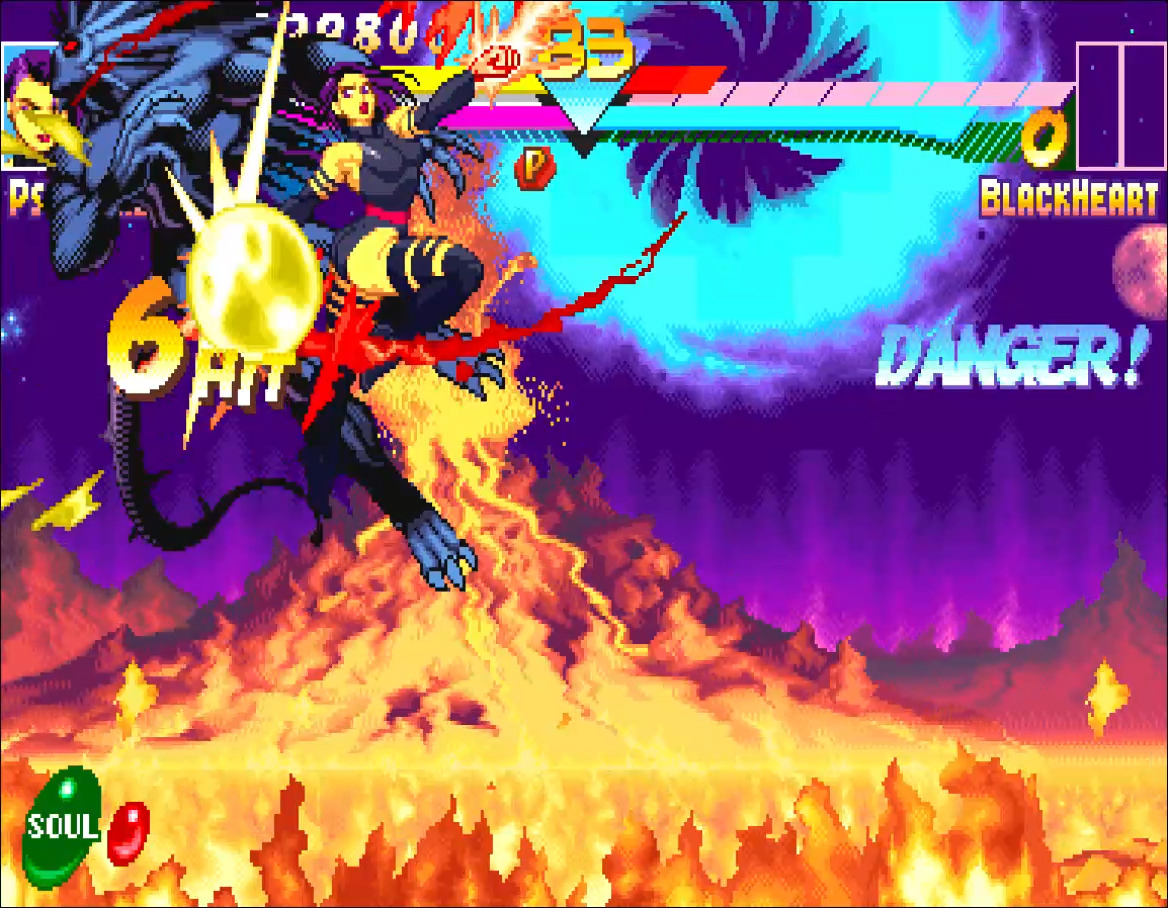
Like Children of the Atom, some special moves allow you to get extra hits by pressing additional buttons. Here, Psylocke’s corkscrew uppercut (psi-blade) gets one spin per kick button. So she’ll get two more spins for two hits each, landing her at 10 total hits for this combo.
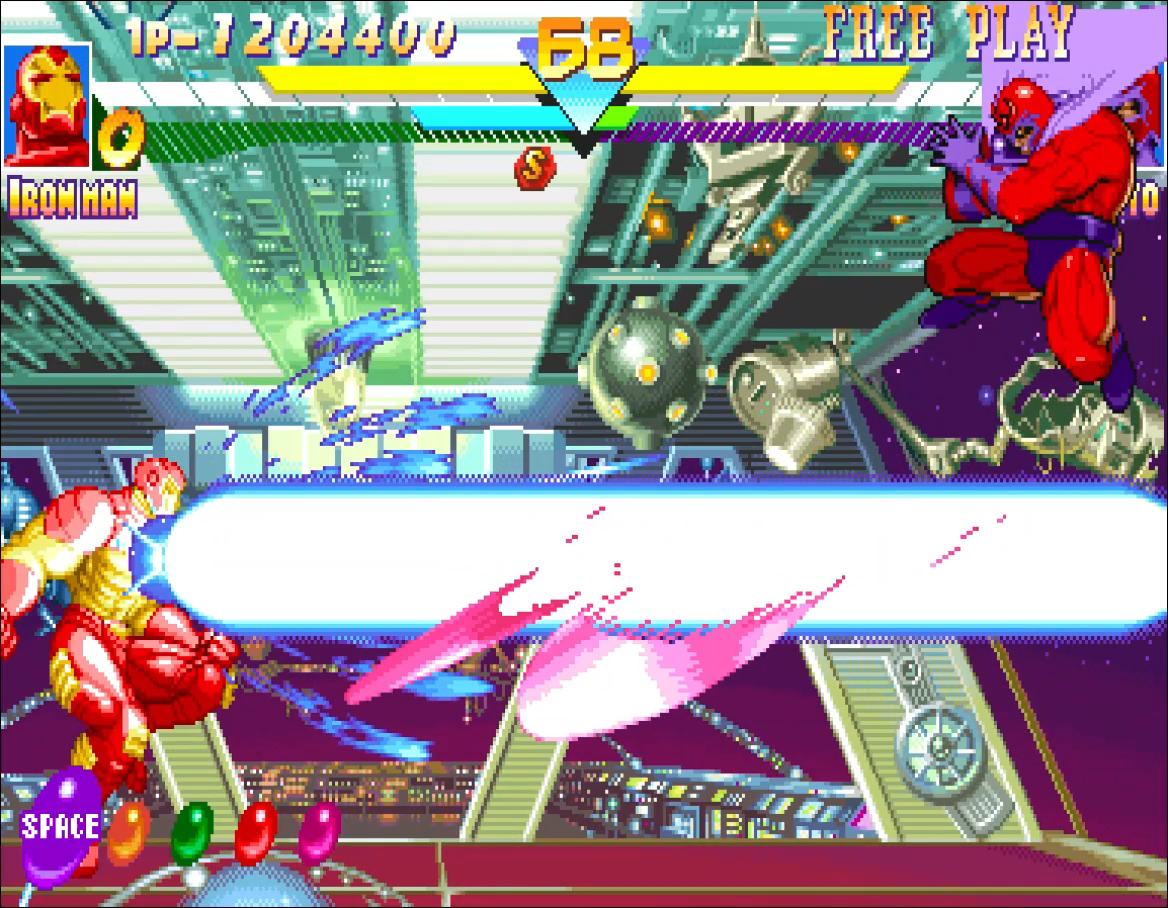
Every character can super jump, but Iron Man, Magneto, and Doctor Doom can also fly. While they cannot block in flight mode, their manueverability allows them to stay out of harm’s way while firing projectiles down.
Most characters can perform the full chain from light punch to a heavy attack in the air (sometimes you can chain heavy punch to heavy kick, but typically they send the opponent flying and end the combo). Often, however, certain attacks in the chain can miss when you jump after them because you start the air combo too high or too low. With Psylocke, I tend to go directly from light punch to medium kick because I can land that more consistently than trying to hit all the buttons in between. But ground combos are a different story for most of the cast. They tend to be character-specific and, Wolverine and Psylocke aside, more restrictive than air combos. Iron Man can chain either his punches or kicks together, but he can’t zig-zag across all six buttons. Shuma-Gorath, on the other hand, can only chain punches into kicks, but, unlike everyone else, he can go down the chain (i.g. heavy punch into medium kick.) Yet, both Shuma and Iron Man can direct their aerial heavy punches forty-five degrees up or down. So, needless to say, there’s still a lot for dedicated players to explore, including finding and executing infinites—not to be confused with Infinity Combos, which are just super moves and will be referred to as such from here on out. Infinites are just as they sound: a combo that can go on forever. While you generally can’t loop an attack chain on the ground, you can air combo, land, jump again, combo again, and loop that forever. Fortunately, it is not easy to do. Infinite does not necessarily mean touch of death. There’s a certain rhythm and timing to an infinite, and it is difficult to sustain that rhythm long enough to actually kill. While that locks out most people from performing a touch of death, it’s also nowhere near impossible. Competitive players can pull them off with ease. As an intermediate player, I enjoy occasionally going in to training mode and trying the perpetual juggles of doom even if I don’t have the execution to land more than a few reps (and get the same damage as my unoptimized, bread and butter Psylocke combos.) Speaking of Psylocke, while earlier I mentioned that she lost a few surface-level extras, she did receive a new intro animation and victory pose in addition to an alternate palette that you can select. While I prefer her old COTA pre and post-fight poses, I always pick the dark gray outfit over her trademark blue. Capcom added a subtle but wicked animation to the start of her super where she closes her hand into a fist, summoning her psychic knife before charging across the screen. Gameplay wise, they reworked her old ninjitsu technique where she surrounds herself with temporary illusory clones and made that a function of the Power Gem, plus they gave her a brand new ninjitsu ability (sans gem) where she teleports to one of the four corners of the screen with illusions occupying the other three. She also gained a second airborne roundhouse (up+heavy kick) where she lashes out with each leg while performing a backflip, which she can use to anti-air, launch even higher to combo further, or cancel into one of her two new super moves—both of which look amazing as she either uppercuts, psi-blades out, all the way to the top of the screen, or she releases a swarm of psionic butterflies to spin around her like a buzz-saw of psychedelic death. 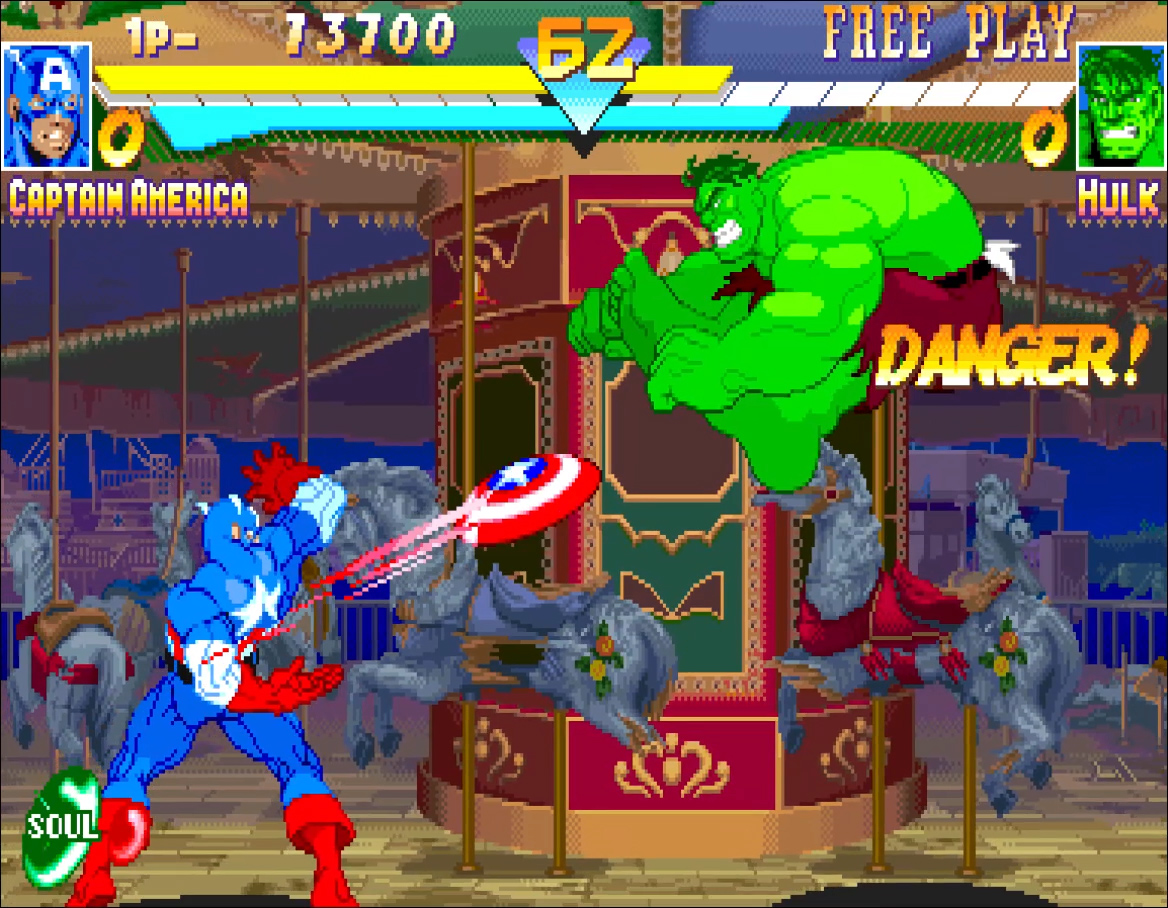
In Street Fighter, the varying button strengths determine a fireball’s power, speed, and (occasionally) range. While that can be true of some COTA/MSH projectiles, others change angles up or down depending on the button used.
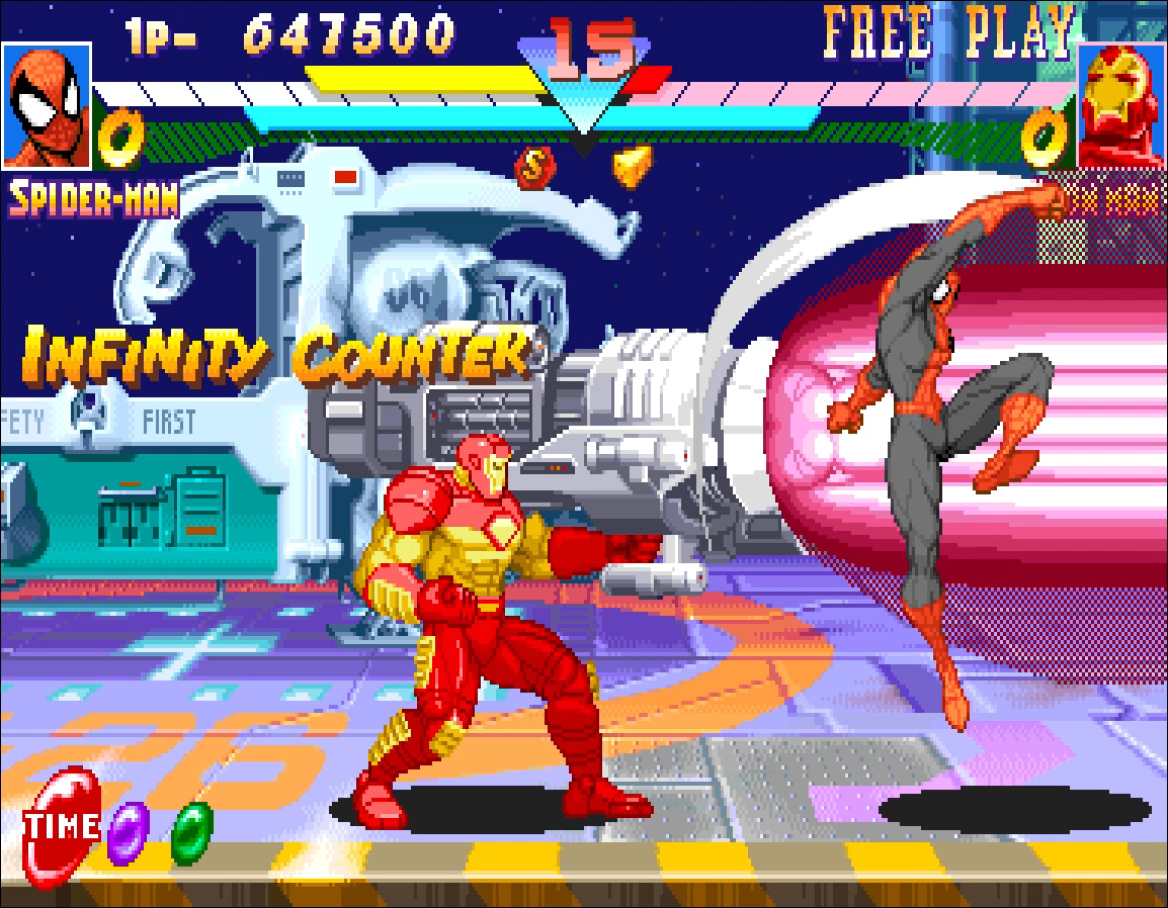
With a full bar of meter, you can perform an Infinity Counter by rolling the joystick from back to down and hitting any punch. It’s not terribly useful except in specific scenarios like avoiding KO by chip damage.
While the new version of Psylocke grew on me, Thanos, the end boss, did not. In fairness, he does more than throw bubbles, and I like many ideas behind his design, but the implementation radically misses the mark. He straight up rips chunks of rock out of the ground and sends it rippling towards his opponent, but then he turns around and runs back and forth like a dork to dodge your jump ins. Before the match starts, he steals all the Infinity Gems from the player and uses them for his super moves, effectively giving him six to choose from—by far his most intimidating attribute ... until you realize you can knock the gems from his gauntlet and strip him of the associated super attacks, weakening him as the match progresses. Hypothetically, you can reclaim all six Infinity Gems and leave him with only basic attacks and special moves, which is far from helpless, but feels counterintuitive and underwhelming in a fighting game. That and he still throws bubbles. In Arcade Mode, you collect five of the six gems (Power, Reality, Soul, Space, and Time) across seven battles with Thanos always holding the Mind Gem in the eighth and final match. In Versus, all six appear seemingly randomly throughout the fight. Each has a universal effect, such as healing, generating super meter, or increasing that character’s speed. In addition, each character has an affinity for one of the gems. For example, Blackheart becomes invisible when he activates the Reality gem, Shuma-Gorath will turn his opponents to stone with the Time Gem, and upon activating the Power Gem, Captain America’s special moves gain flashy shadow trails along with additional combo and damage potential. A character can only use one Infinity Gem at a time; however, they can hold all six. The start button cycles through the gems, and a quarter-circle-back + two punches will activate the one in the left-most ready position. Effects last for a short time, but the results can be devastating—even a masher can perform an infinite in the corner with the Time Gem just spamming one button. And a player is encouraged to use them immediately or at least cycle to a less desired gem, as opponents can knock the readied gem free with a special move—any special move—whereupon they fall to the floor for either character to pick up. I don’t typically use gems, personally. While they can introduce a dash of fun chaos into a casual match, I play arcade mode almost exclusively, and I can reliably beat the AI with Psylocke even on the hardest difficulty (don’t be impressed; it’s an easy game). That and most hero endings, including Betsy’s, explicitly state they don’t use the gems (I’m weird with my immersion in fighting games.) The few times I do activate them, usually when playing another character, I do so just to deny the AI the ability to turn their power on me because, yeah, it royally sucks working extra hard to get results that come effortlessly with your main only to have the CPU activate the Soul Gem and effectively erase one of your combos ... and then activate the Power Gem and kill you with one input-reading super that counters what you were trying to do. 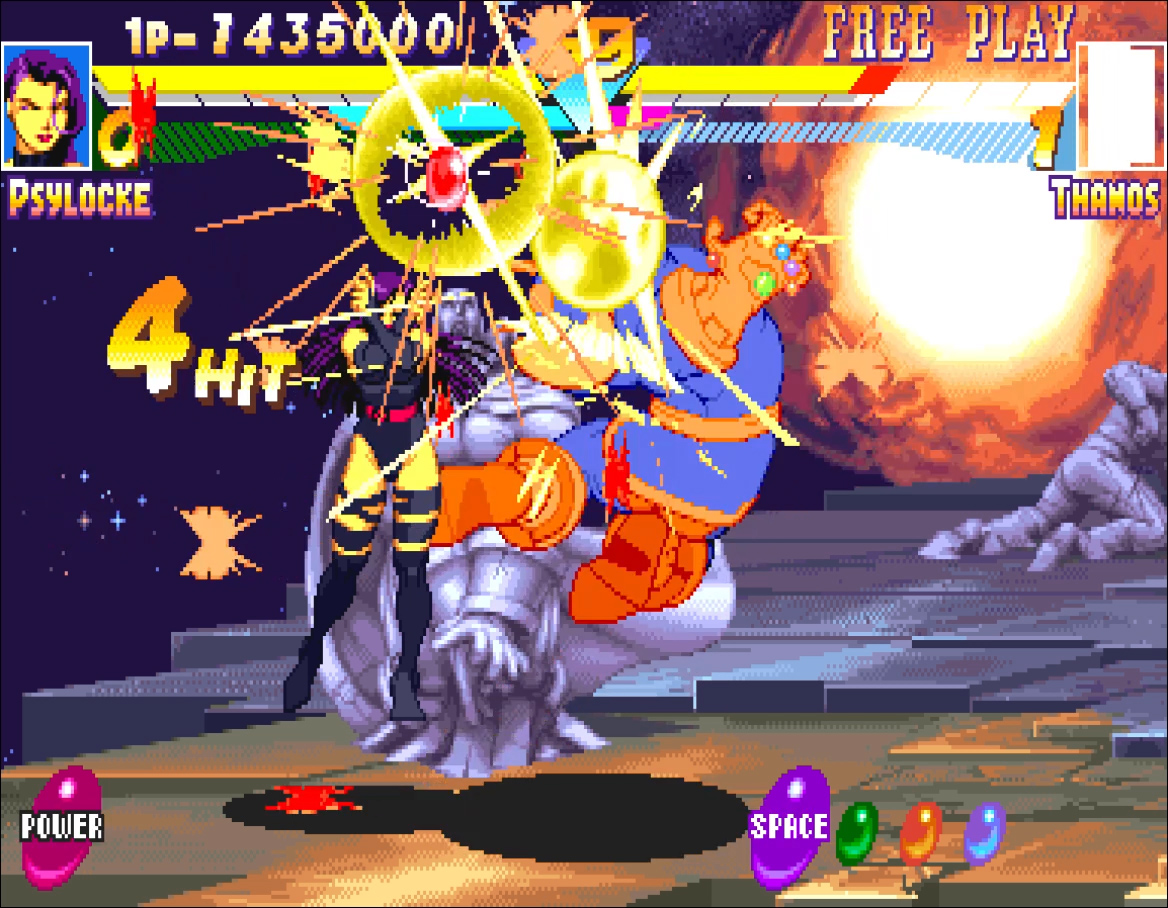
If you play as Thanos, he functions like every other character and does not need a gem to use his supers; however, that also means special moves can knock gems from his gauntlet like every other character.
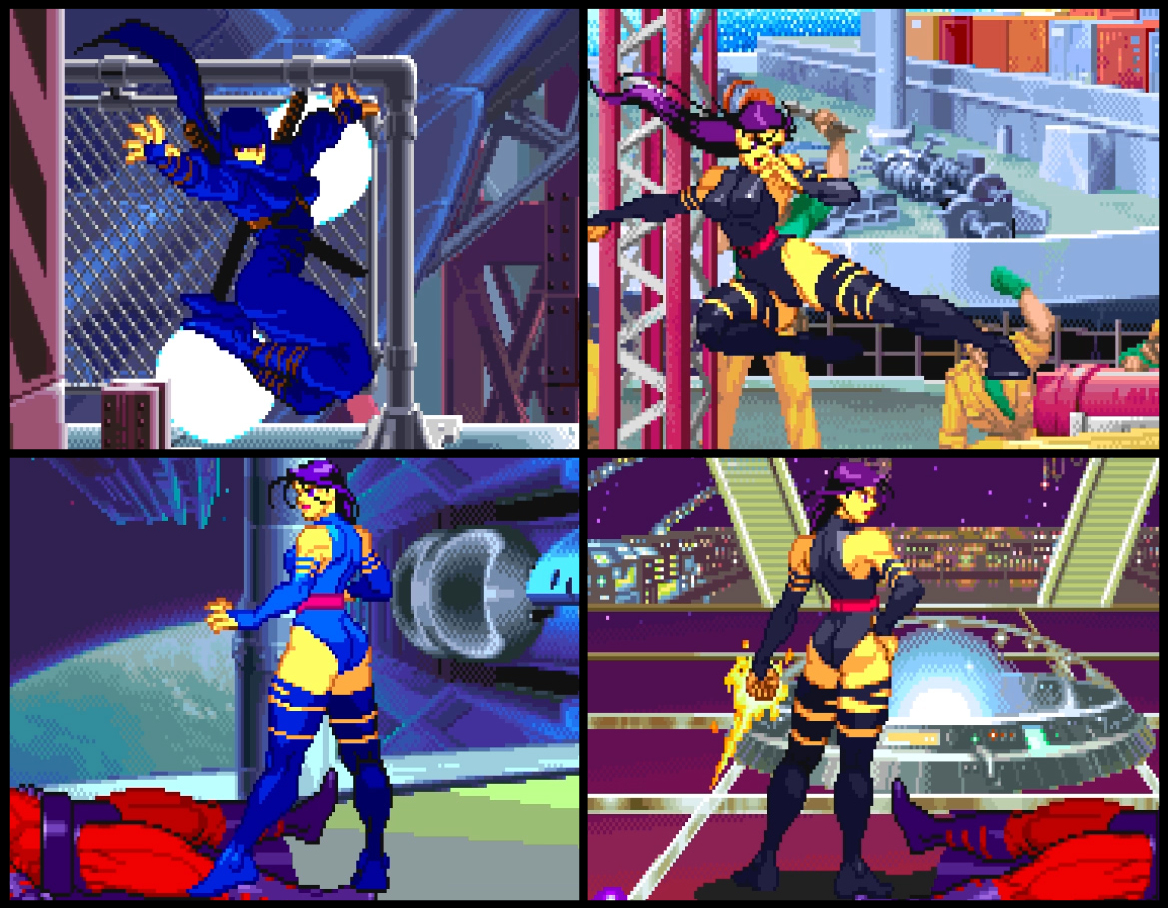
It’s not that the Marvel Super Heroes entrances and victory poses are bad, I just think Psylocke showing up in a ninja outfit and the animation of her “hopping” into her victory pose in X-Men: Children of the Atom are better.
But what keeps me coming back to Marvel Super Heroes more so than any other fighting game nearly thirty years later? Many reasons, but a big one is actually the aforementioned easy AI. Arcade fighters in this time period had five to eight levels of difficulty with no appreciable difference between them because the CPU just countered whatever button you pressed 95-99% of the time. Throw a fireball in Ultimate Mortal Kombat 3, Super Street Fighter II Turbo, or X-Men: Children of the Atom, and watch the computer jump over it the exact moment you push the button. Every. Single. Time. Use medium punch? It intercepts with light punch and starts a combo. Every. Single Time. It can’t counter you? It guards and guards and guards. Every. Single. Time. And you can’t break through with mix ups because it knows what you’re doing. At. All. Times. You literally can’t play the game. I hesitate to call this hard, however, because you can still win quite decisively (and relatively easily) with exploits. That’s how I found out COTA Psylocke can super jump to the top corner of the screen and shoot psi-blasts down the whole match, slowly chipping away at the CPU’s health until the time runs out because it doesn’t know what to do when it can’t jump over fireballs. Now, I think it’s awesome Psylocke has this tool in her kit, but that doesn’t mean I want to use said tool the entire round every god damn round. It would be nice if the difficulty settings in these games functioned like they should (i.e. easy is easy, hard is hard, and you have three to six degrees of medium in between), but they don’t. Not even Marvel Super Heroes. The difference is Marvel Super Heroes, while it does button read and counter, it’s not so frequent that you have to resort to exploits. It lets non-tournament players get in, combo, launch, super jump, and then air-combo. But at the same time, the CPU opponents don’t just stand there. I struggle when I use anyone but Psylocke. But even when I do use someone else, I can still play the game. That drives me to experiment, learn, and get better. And that’s what keeps me coming back, even if I don’t have anyone else to play against. | ||||||||||||||||||||
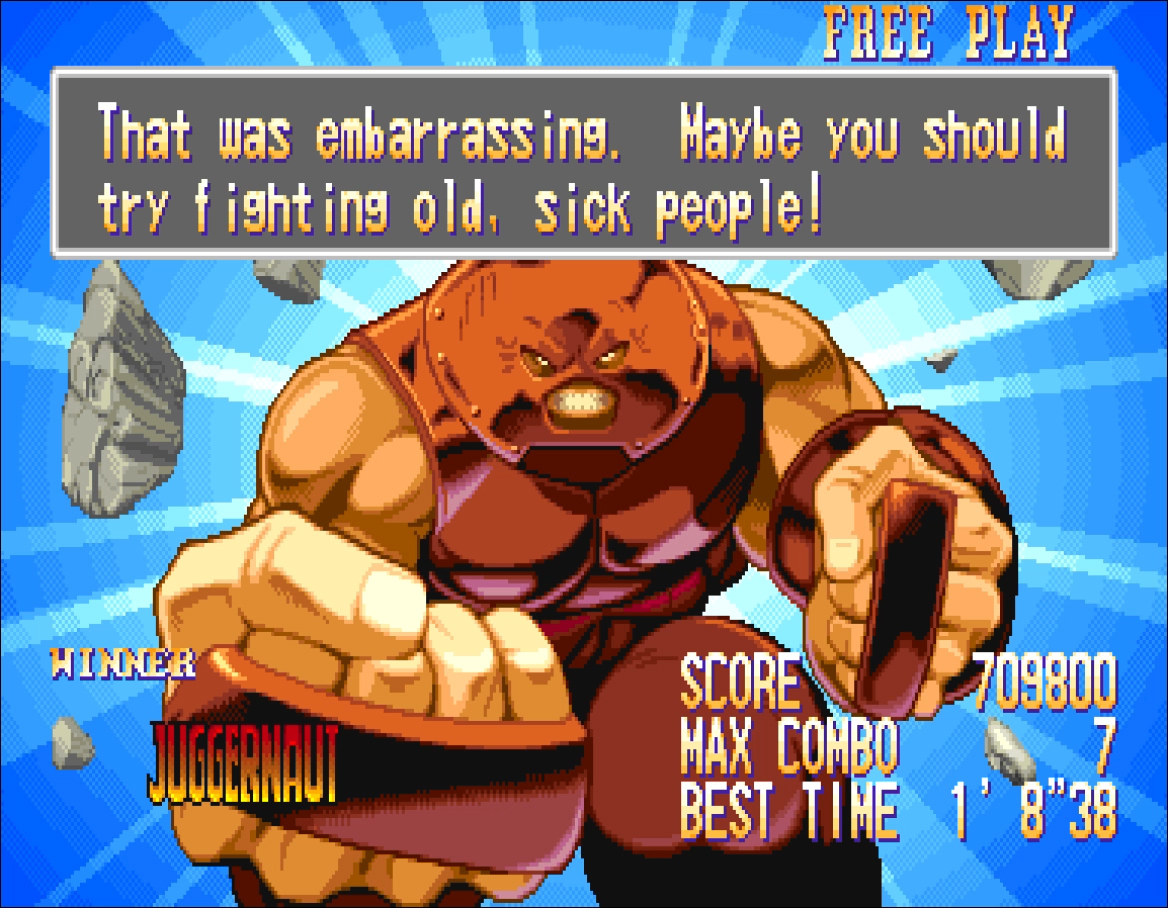
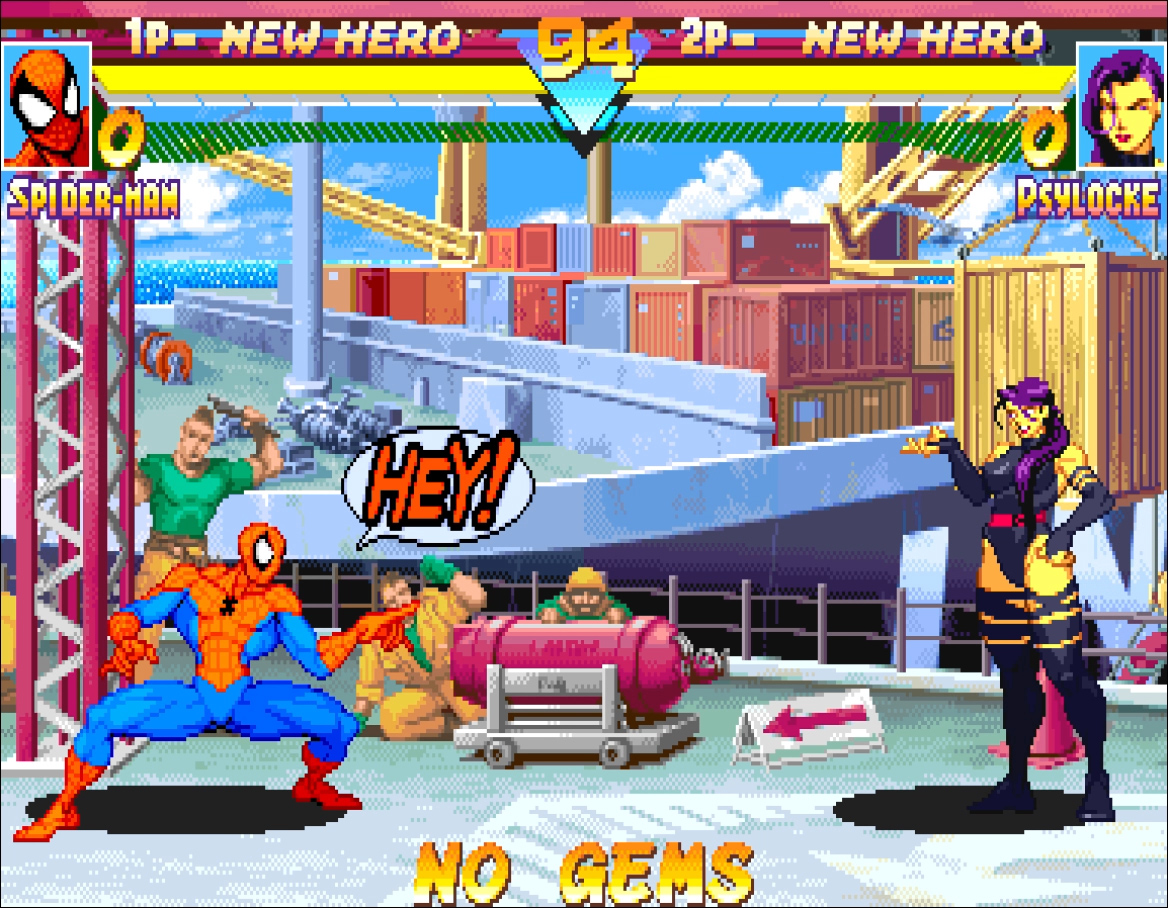
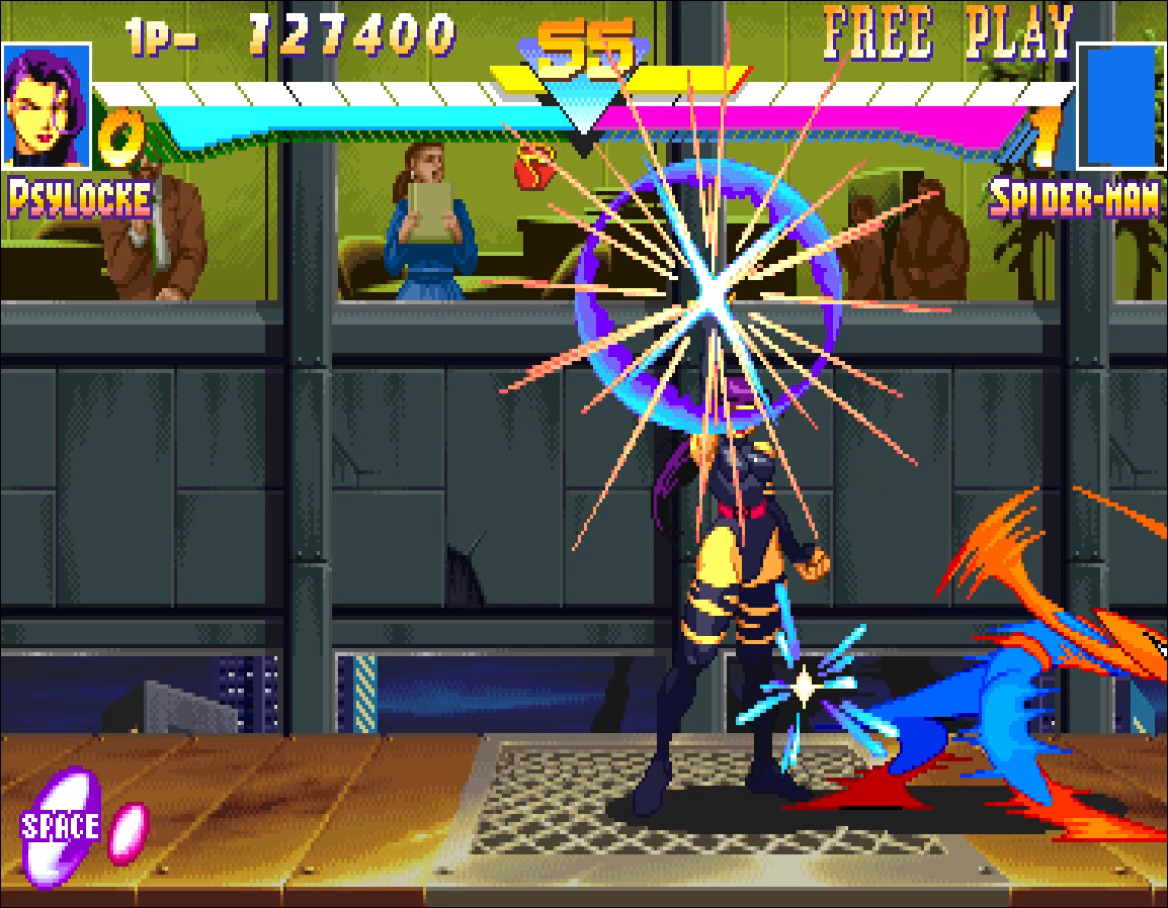
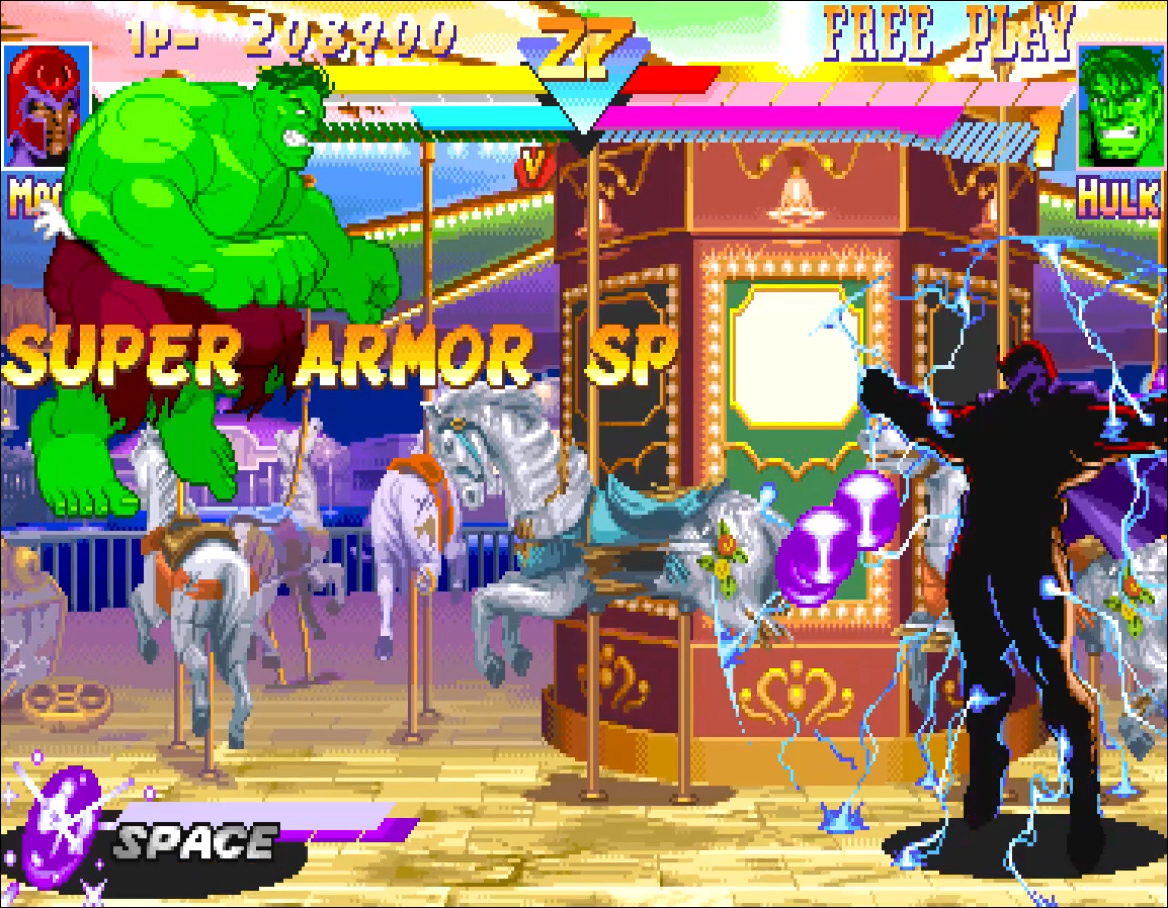 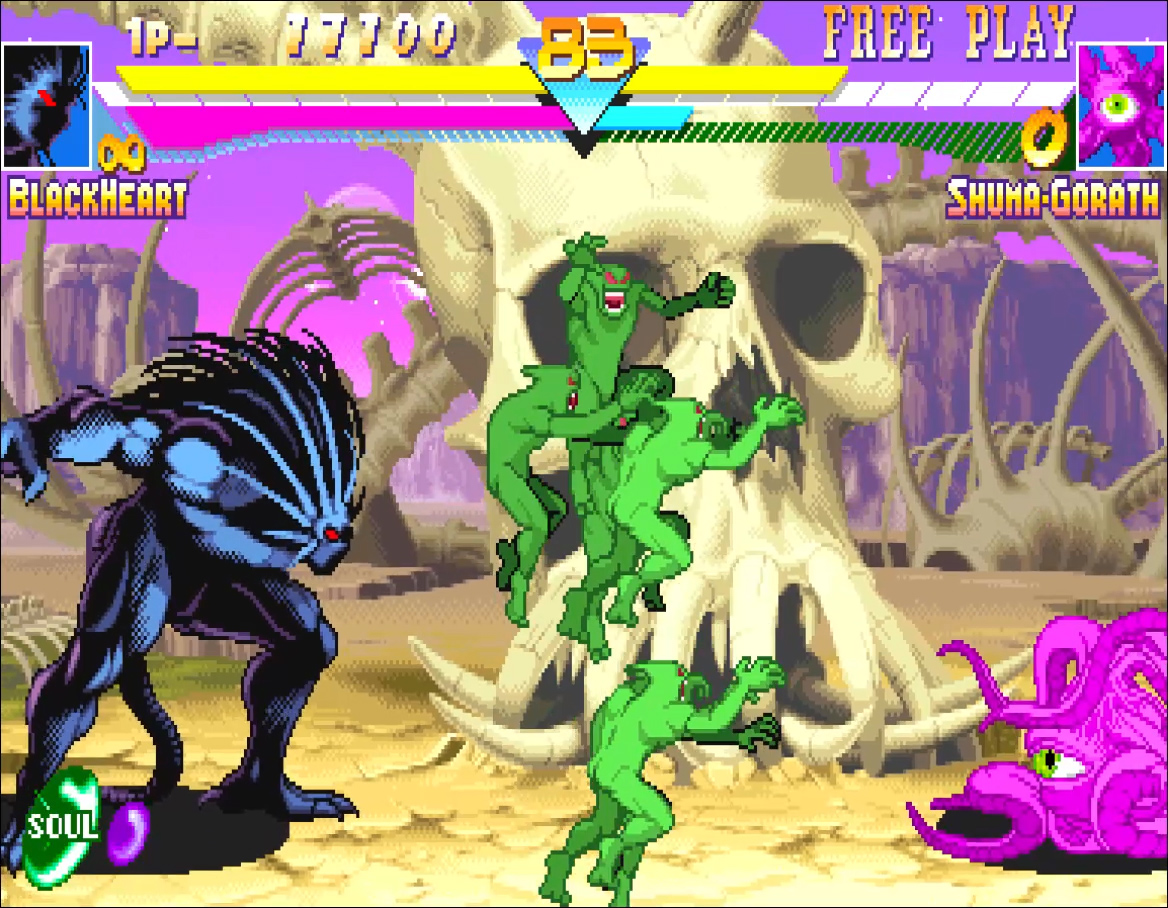
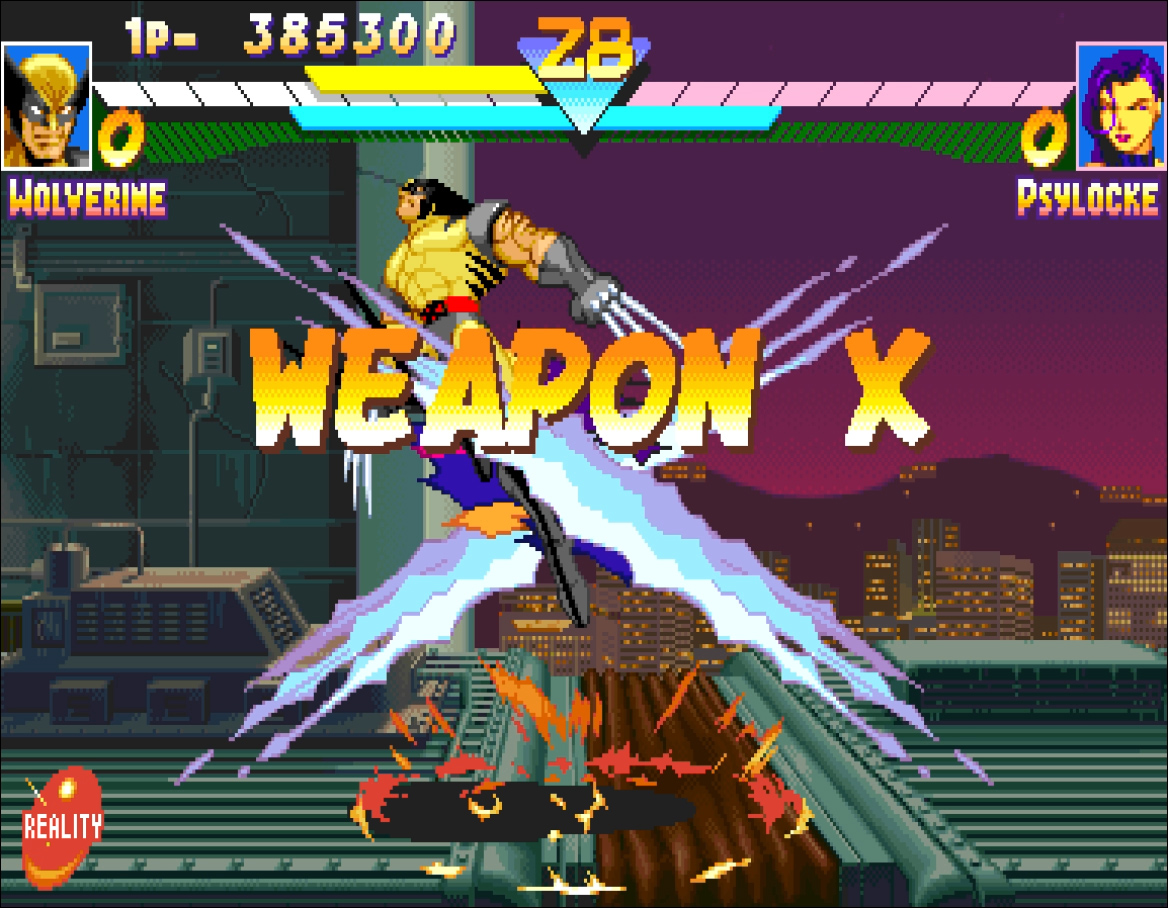
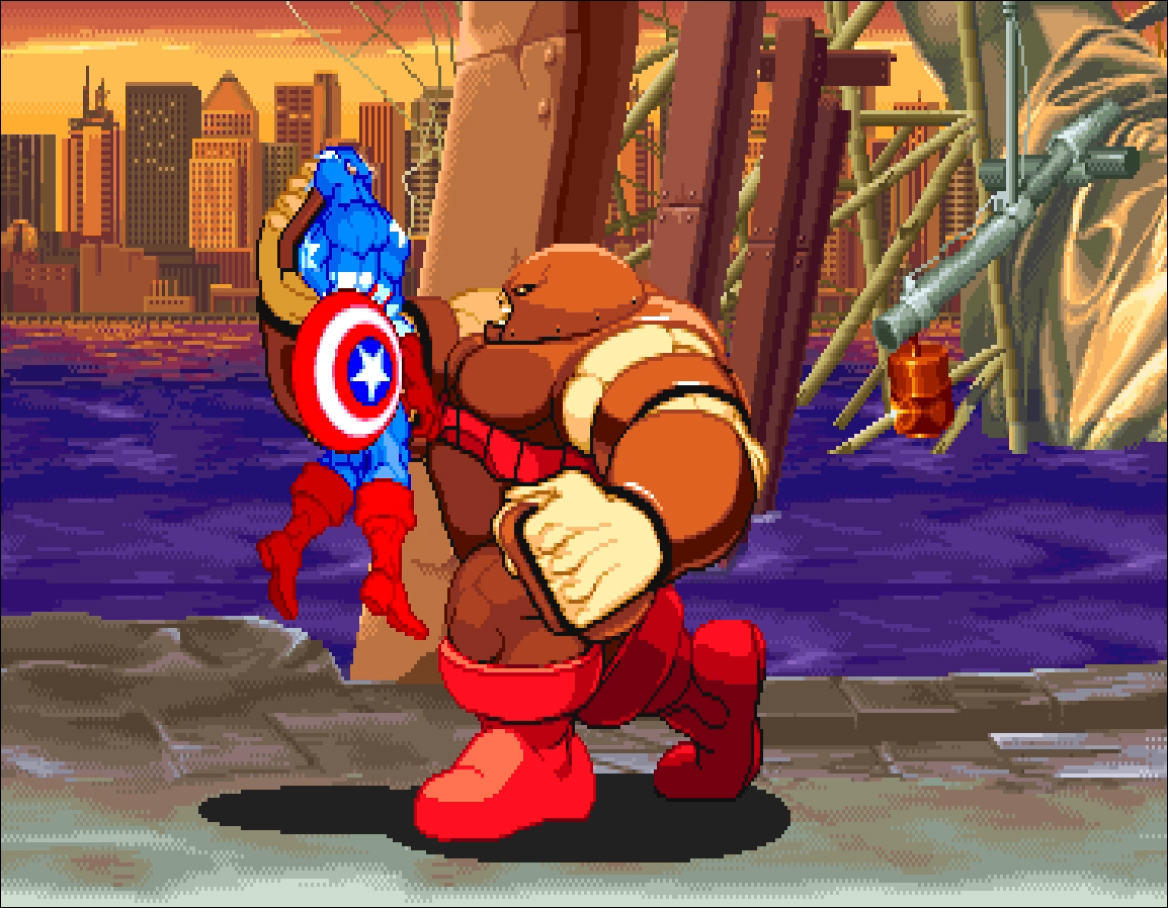 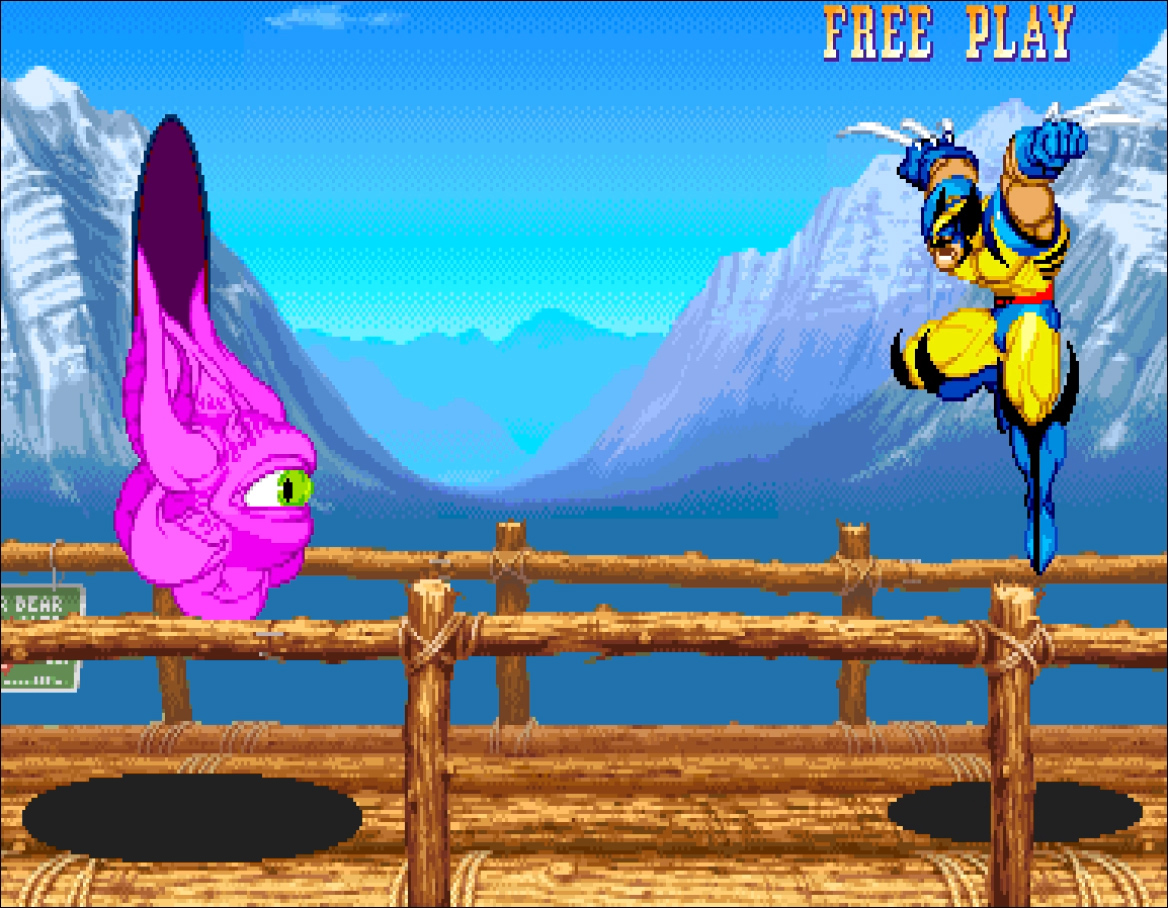
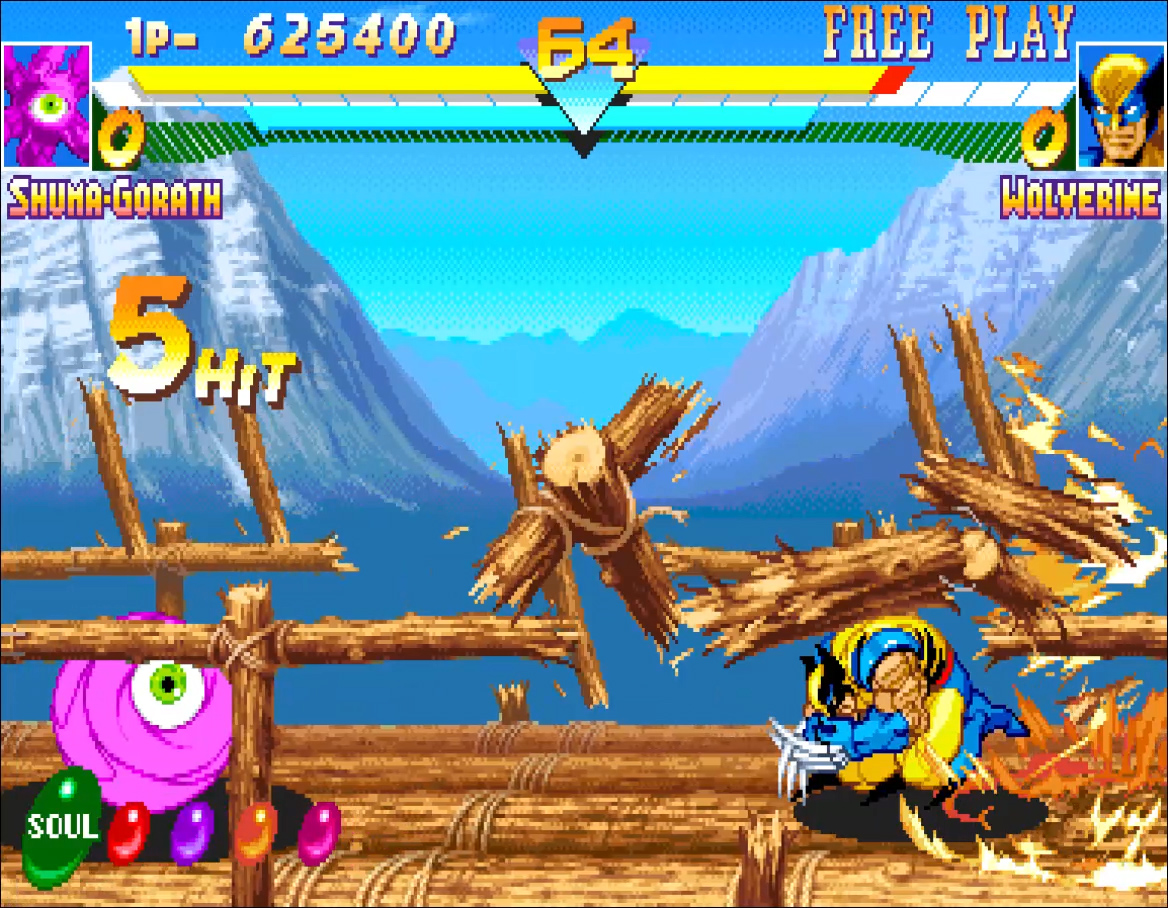
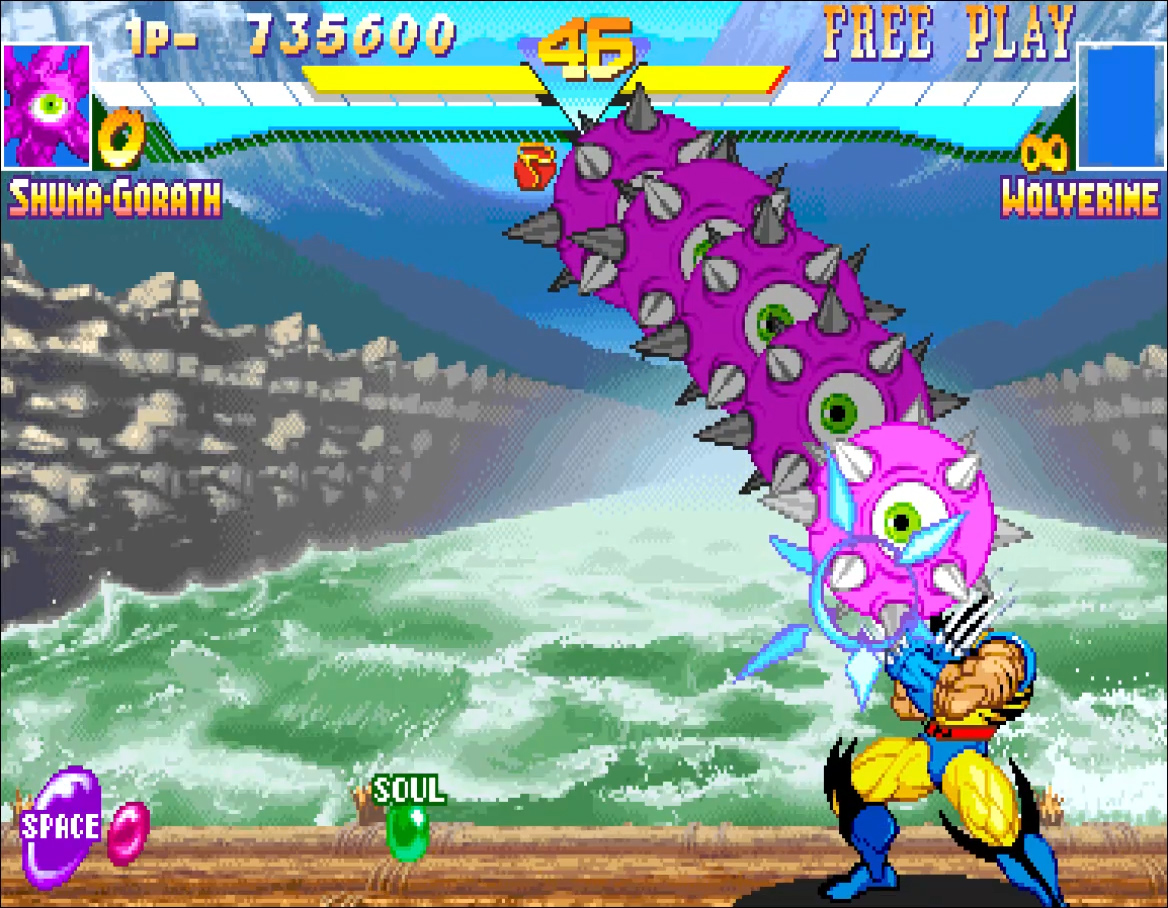
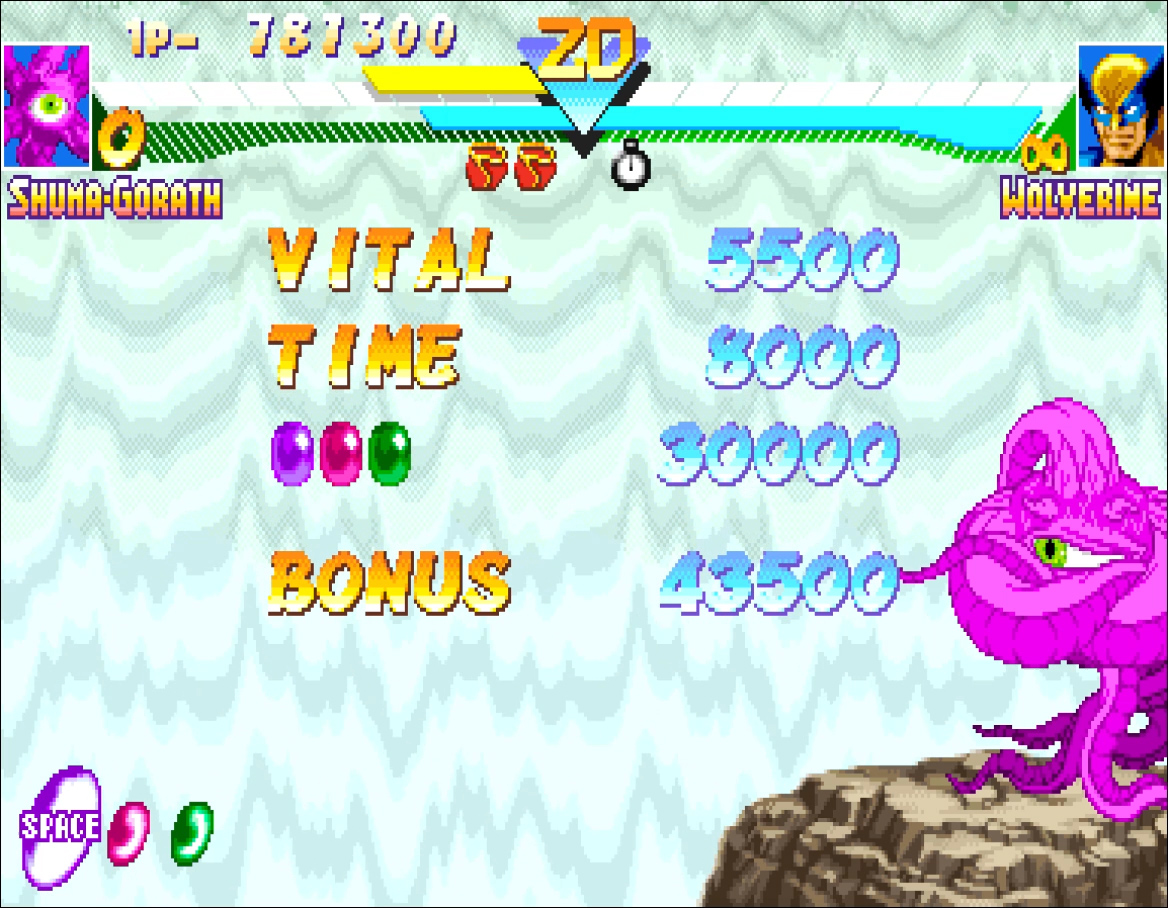
Stage transitions still exist, but they’re not as dramatic as X-Men: Children of the Atom. Wolverine's stage comes the closest with the bridge supports breaking, and the bridge, itself, falling to the river below.
| ||||||||||||||||||||
|
| ||||||||||||||||||||
